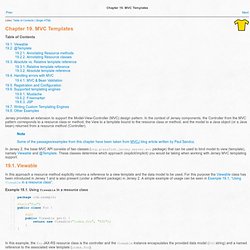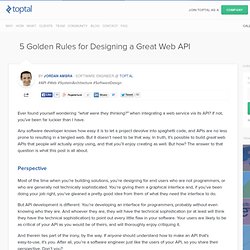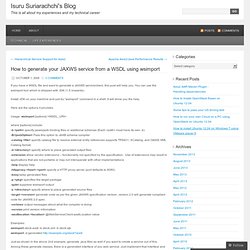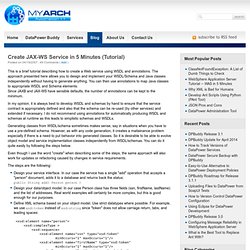

Chapter 19. MVC Templates. Jersey provides an extension to support the Model-View-Controller (MVC) design pattern.

In the context of Jersey components, the Controller from the MVC pattern corresponds to a resource class or method, the View to a template bound to the resource class or method, and the model to a Java object (or a Java bean) returned from a resource method (Controller). Note Some of the passages/examples from this chapter have been taken from MVCJ blog article written by Paul Sandoz. In Jersey 2, the base MVC API consists of two classes (org.glassfish.jersey.server.mvc package) that can be used to bind model to view (template), namely Viewable and @Template. These classes determine which approach (explicit/implicit) you would be taking when working with Jersey MVC templating support. Mule ESB : Most Popular Open Source ESB - Enterprise Service Bus. Web API Design: 5 Best Practices to Know. Ever found yourself wondering “what were they thinking?”

When integrating a web service via its API? If not, you’ve been far luckier than I have. Any software developer knows how easy it is to let a project devolve into spaghetti code, and APIs are no less prone to resulting in a tangled web. But it doesn’t need to be that way. In truth, it’s possible to build great web APIs that people will actually enjoy using, and that you’ll enjoy creating as well. Perspective Most of the time when you’re building solutions, you’re designing for end users who are not programmers, or who are generally not technically sophisticated. But API development is different. And therein lies part of the irony, by the way. Well, while you certainly understand their perspective, you don’t necessarily share their perspective. API designers typically focus on questions like “What does this service need to do?”
These different questions lead to two vastly different perspectives. Rule 1: Documentation. E-gob. How to generate your JAXWS service from a WSDL using wsimport. If you have a WSDL file and want to generate a JAXWS service/client, this post will help you.

You can use the wsimport tool which is shipped with JDK (1.5 onwards). Install JDK on your machine and just try “wsimport” command in a shell. It will show you the help. Here are the options it provides. Usage: wsimport [options] <WSDL_URI> where [options] include:-b <path> specify jaxws/jaxb binding files or additional schemas (Each <path> must have its own -b)-B<jaxbOption> Pass this option to JAXB schema compiler-catalog <file> specify catalog file to resolve external entity references supports TR9401, XCatalog, and OASIS XML Catalog format. Examples:wsimport stock.wsdl -b stock.xml -b stock.xjbwsimport -d generated Just as shown in the above 2nd example, generate .java files as well if you want to create a service out of this.
These details should be according to your WSDL’s definitions. Like this: Like Loading... Related. Create JAX-WS Service in 5 Minutes (Tutorial) This is a brief tutorial describing how to create a Web service using WSDL and annotations.

The approach presented here allows you to design and implement your WSDL/Schema and Java classes independently without having to generate anything. You can then use annotations to map Java classes to appropriate WSDL and Schema elements. Since JAXB and JAX-WS have sensible defaults, the number of annotations can be kept to the minimum.
In my opinion, it is always best to develop WSDL and schemas by hand to ensure that the service contract is appropriately defined and also that the schema can be re-used (by other services) and extended if necessary. I do not recommend using annotations for automatically producing WSDL and schemas at runtime as this leads to simplistic schemas and WSDLs. Generating classes from WSDL/schema sometimes makes sense, say in situations when you have to use a pre-defined schema. The steps are the following: Design your service interface. Complete schema file Sample XML file. How to initialize Spring Framework inside JAX-WS Service. This page describes how to write a JAX-WS, Spring Framework based web service.

JAX-WS makes it easier to write web services in Java. It shilds the programmer from implementation specifics just like JDBC API did for databases. The two popular implementations out there are the Apache CXF and the Java Reference Implementation. This page describes an application that will run on both. The project will be tested in Tomcat 6 with the Reference Implementation and we will move to JBoss that has a built in CXF implementation.
Few Notes about the application servers Tomcat 6 does not ship with JAX-WS RI (needs to be installed) or the Spring Framework (needs to be included in the WAR)JBoss 5.1 has the CXF and Spring Framework built in to the server. Software versions. SOAP Binding: Difference between Document and RPC Style Web Services. Complex Type: ConsultaCoberturaRequestTO.